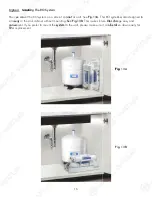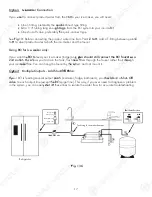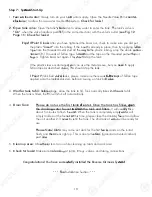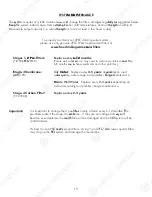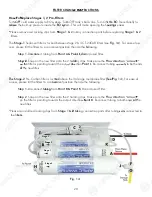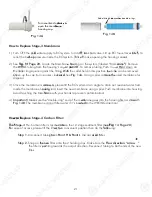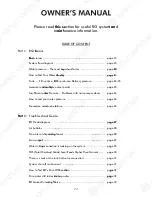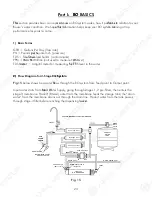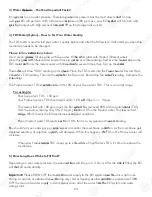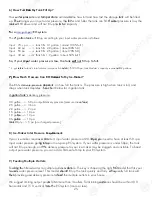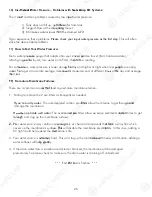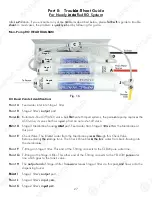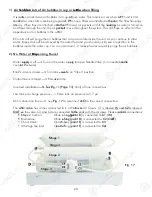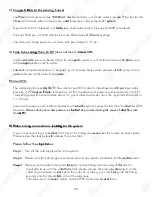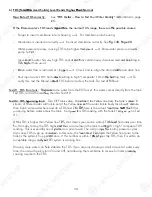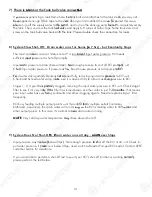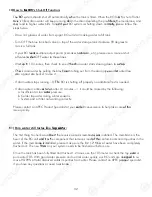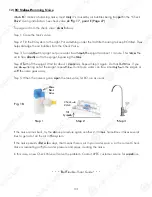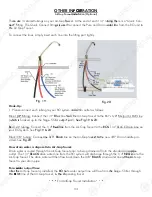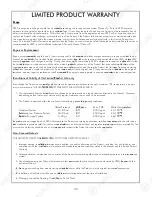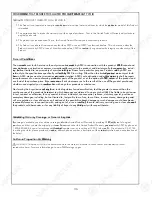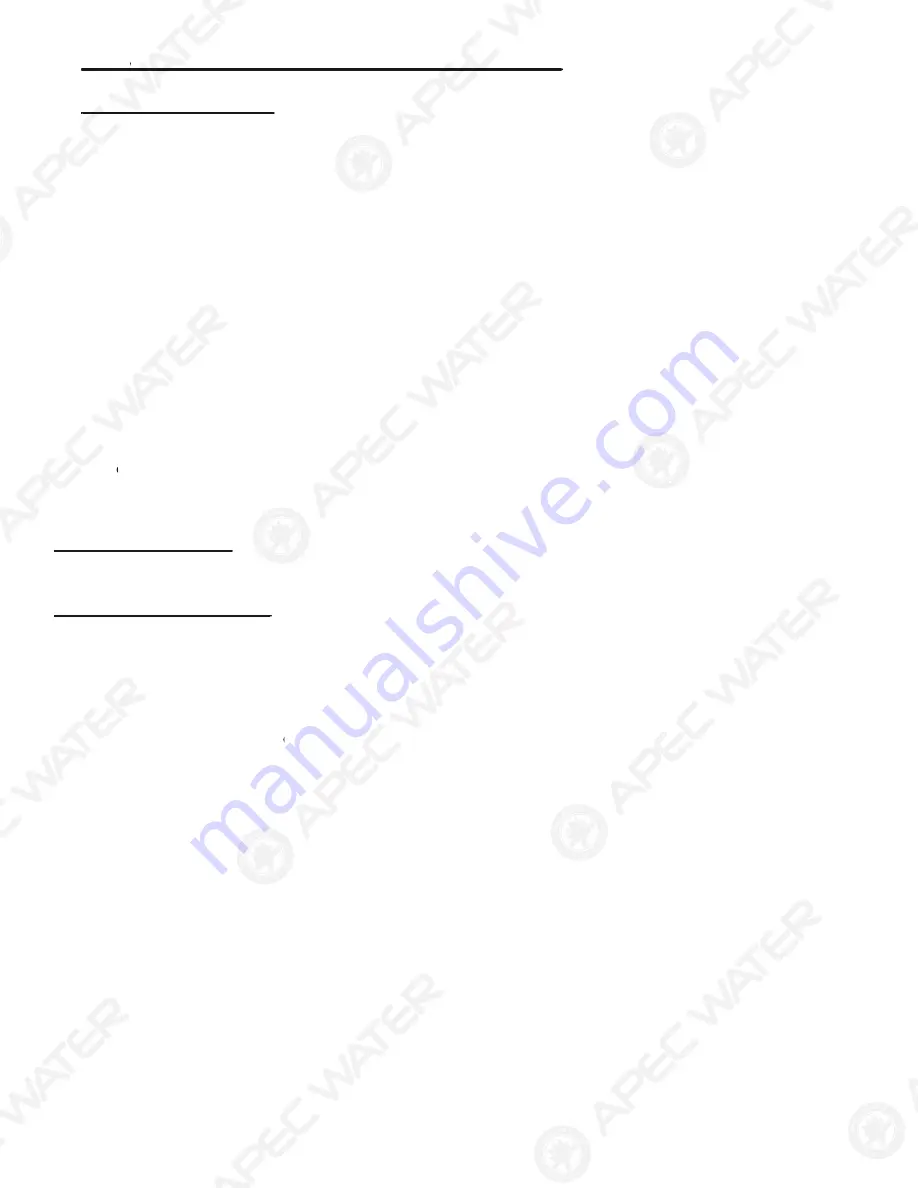
30
- Forgot to insert membrane into its housing
—>
Put membrane into housing.
- Membrane is inserted incorrectly
—>
Re-insert membrane correctly. See
Fig.14B
,
Page 20
.
- Water pressure too low, causing TDS to be higher than usual
—>
Raise water pressure or add
pump to RO.
- Input source water has very high TDS and/or contains certain heavy dissolved elements resulting in
TDS higher than usual.
- Drain water flow is restricted or clogged
—>
Check and re-align the drain saddle and drain line.
- Your input water’s TDS fluctuates resulting in high “composite” TDS in the holding tank
—>
To
verify this, test the filtered water’s TDS before it enters the tank. Do test as follows:
Test #1 TDS from tank:
Dispense some water from the RO faucet, this water comes directly from the tank.
Test TDS, record the reading, then Do Test #2.
Test #2 TDS bypassing tank:
Turn OFF tank valve. Disconnect the Yellow line from the tank’s valve. A
stream of filtered water will trickle out of the Yellow line. Let the water trickle freely for about 1 minute,
then Catch some water here and do a TDS test. The TDS here is the actual
“real time TDS”
the RO is
producing before water enters the tank. Compare this TDS reading with the tank’s TDS you get in Test
#1.
If tank TDS is higher than Yellow line TDS, that means your source water’s TDS level fluctuates over time.
So, from day to day, the TDS highs and lows accumulate in the tank resulting in a high “composite TDS”
reading. This is especially true if you’re on a private well. The well pump’s fluctuating pressure cycles
also cause TDS to go up and down. In this case, the
“real-time”
TDS from the Yellow line (prior to the
tank) is the system’s true performance. If this number is within 10% of your tap TDS, then it is within an
acceptable range, and your RO system is working fine.
Drawing more water can help stabilize the TDS. If you are only drawing a small amount of water every
time, the unit will quickly turn On and Off, not allowing the membrane to receive full inlet pressure,
causing a spike in the TDS.
6) TDS (Total Dissolved Solids) Level Reads Higher Than Normal
How to test TDS correctly:
See
“TDS Meter -- How to Test Your Water Quality”
instructions on page
25.
If the filtered water’s TDS reads higher than the normal 10% range, these are the possible causes:
30
- Forgot to insert membrane into its housing
—>
Put membrane into housing.
- Membrane is inserted incorrectly
—>
Re-insert membrane correctly. See
Fig.14B
,
Page 20
.
- Water pressure too low, causing TDS to be higher than
an
u
usu
sual
W
—>
Raise water pressure or ad
ad
d
d
pump to RO
O
.
- Input
t
so
so
ur
ur
ce
ce
water has very high TDS and/or
r
co
cont
nt
a
ains certain heavy dissolved element
nt
s
s
re
re
su
su
lting in
TD
D
S
S
hi
hi
gh
gh
er than usual.
-
-
Dr
Dr
ain water flow is restricted or clogge
ge
d
d
—
—>
Check and re-align the drain sad
addl
dle and drain line.
- Your input water’s TDS fluctuat
ates
es
r
resulting in high “composite” TDS in
th
th
e
e ho
ho
ld
lding tank
YY
—>
To
verify this, test the filtered wat
ater
er
’s
’s TDS before it enters the tank. Do test as
s f
f
ol
ollows:
Test #1 TDS from tank:
D
Dis
is
pe
pens
nse
e some water from the RO faucet, this water comes directly from the tank.
Test TDS, record the readi
di
ng
ng
, then Do Test #2.
Test #2 TDS bypassing tank:
yp
g
Turn OFF tank valve. Disco
o
nn
nn
ec
e
t the Yellow line from the tank’s va
a
lv
v
e.
e. A
A
stream of filtered water will trickle out of the Yellow li
li
ne
ne
.
.
Le
Le
t
t the water trickle freely for about
ut
1
1 m
min
in
ute,
then Catch some water here and do a TDS test. Th
The
e TD
TDS
S here is the actual
“real time TDS
DS
”
”
t
the
he RO is
produc
uc
ing before water enters the tank. Compa
pa
re
re t
t
hi
h
s TDS reading with the tank’s TD
D
S
S
yo
yo
u get in Test
#1
.
If
If t
t
a
ank TDS is higher than Yellow line T
T
DS
DS
,
,
th
t
at means your source water’s TDS
DS
l
lev
evel
el
fluctuates over time.
YY
So
S
, from day to day, the TDS highs a
a
nd
nd
l
lo
ows accumulate in the tank resulti
ting
ng
i
i
n
n a high “composite TDS”
reading. This is especially true if
f
yo
yo
u’
u’re
re on a private well. The well pump’
p
s
s fl
fl
u
uctuating pressure cycles
also cause TDS to go up and
d
do
dow
wn. In this case, the
“real-time”
TD
TD
S
S
from
om
the Yellow line (prior to the
tank) is the system’s true
e
p
p
er
e
fo
o
rm
rm
ance. If this number is within 1
0%
0%
o
of
f
y
your tap TDS, then it is within an
acceptable range, an
n
d
d
yo
yo
ur
ur
RO
O
system is working fine.
Drawing more water can
h
help stabilize the TDS. If you are only drawing a small amount of water every
time, the unit will quickly turn On and Off, not allowing the membrane to receive full inlet press
ssur
ur
e,
e,
causing a spike in the TDS.
6) TDS (T
( ot
t
al
al D
Dis
is
so
lved Solids) Level Reads Highe
e
r
r
Th
Th
an
an
Normal
)
g
TT
Ho
o
w
to
to test TDS correctly:
y
See
“TDS M
M
et
et
er
er
-- How to Test Your Water Quality
y
”
in
n
st
st
r
ructions on page
25.
If
If the filtered water’s TDS reads h
ig
ig
he
her
r th
th
an
the normal 10% range, these are t
the
he possible causes:
Summary of Contents for Ultimate RO-QUICK90
Page 2: ......

